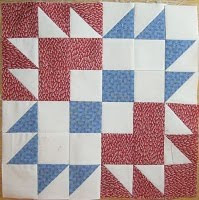Wool Dying Methods
Debbe Sheridan shared this info with us in November, she got this info from Linda Sharp who was in the November 2010 Quilt Arts calendar.
Dying with Kool-Aid
"Kool-Aid dyeing gives absolutely delicious colors to protein fibers," says Linda. "This process is safe, inexpensive, and easy. The materials are readily available, it requires no special equipment, and it smells wonderful!"
Materials
Natural (protein) fibers such as wool, dog hair, alpaca, angora, silk, etc. (Loose fibers, like dog hair, can be stuffed into a loosely woven synthetic gift bag to keep them together while dying.)
Dish detergent
Packets of unsweetened Kool-Aid drink mix. (Do not use the color-change flavors.)
Mask
A stainless steel or un-chipped enamel pot
Water
Wooden stirrers (such as chop sticks)
Optional: Candy thermometer, rubber gloves
Note: A good ratio to begin with is 1 package of Kool-Aid to 1 ounce of fiber. (Double this for the lemon flavor.) More Kool-Aid will give you stronger colors. You can mix colors if you're feeling adventurous. Use unsweetened Kool-Aid and do not add sugar.
Directions:
Gently wash your fiber with lukewarm water and a little dish detergent and rinse the soap out. Treat wool very gently or it will felt. Let your fiber soak in lukewarm water while you prepare the dye.
Fill the pot with enough water to comfortablly cover your fiber. Put on your mask before opening the Kool-Aid package(s) to avoid inhaling the powder. Stir the powder into the water with the wooden chopsticks until dissolved.
Add the wet fiber to the pot and slowly heat to just below boiling (85 degrees C or 185 degrees F). You can use a candy thermometer, if yuo have one. Check periodically to see that the mixture is not boiling, to avoid felting the wool. The dyeing process is done when the water is clear. You can tell by dipping the chopsticks in the water. This process will probably take about half an hour.
When the water is clear, move the pot off the heat and let it cool. Then gently rinse it with water that is the same temperature as the fiber. Hang to dry. The colors will be lightfast and colorfast, no heat-setting is required.
"This is a great way to get a bit of silk or wool the color you want, ot overdye a batch of garish fibers, or to get matching colors. Dye many batches now, and you'll have a cache of beautifully colored fibers that smell like summer all winter long."
Easter Egg Dye in the Microwave for Wool
Easter Egg dye tablets
Mason jar
Water
White Vinegar
Drop one tablet into mason jar and fill half way with water, add 2 tablespoons vinegar, then stir. Add wool roving or small strips of wool or yarn. Add water to near top of jar to completely cover the wool. If all the wool is not immersed the wool exposed can singe.
Microwave for 2 minutes on high. Then let the wool immersion cool. Just oper the microwave door and walk away....
Microwave for 2 more minutes. Let cool. At this point the water should be clear, the dye absorbed. Remove the wool, rinse and hang to dry.
Tea Dye Wool Yarn or Wool Fabric
Synthropal
Tea bags or loose tea
Glass bowl
Boiling water
Soak yarn or wool in 1 teaspoon synthropal per gallon of water for 20 minutes.
Gently wring out.
Place tea bag in glass bowl and pour over the tea bag one cup of boiling water. Let the tea steep for a few minutes. Remove the tea bag.
Add yarn or wool and stir gently. Place bowl or wool in microwave until tea nearly boils, remove and stir. Let sit for 10 minutes to over night until you get the desired results. The will will not be clear at end of dyeing process.
Rinse in clear water. Hang to dry.
Tea can be used again for another dye bath.
Food Color Dye for Wool
1 Tablespoon white vinegar per 1 cup of water
10-20 drops of food coloring based in intensity of color
Synthrapol
Soak yarn in 1 tsp Synthrapol to 1 gallon of water for 20 minutes. Gently wring out. Heat the ater and vinegar on the stove. Add the wool and stir gently. If using yarn, be careful when stirring as it is possible to felt the yarn into a ball.
Bring to a boil. Remove from the heat. The wate in most cases should be clear, the dye absorbed. When cooled, remove wool and rinse. Hang to dry.
Sharpie Marker Dye Technique
Freezer paper
Chisel Tip Sharpie Markers
Rubbing alcohol in spray mister bottle
Silk scarf
Coffee filter
Lay a piece of freezer paper shiny side up on the table. Lay out silk scarf or coffee filter. Create patterns with the markers, using strong strokes. Then spray lightly with the rubbing alcohol and watch the colors run together creating beautiful patterns. Hag to dry.
Books: Magic with Markers by Sherrill Kahn and Creative Dyeing for Fabric Arts by Suzanne McNeill
Ziploc Bag Dye for Silk
Color Hue Instant Setting Dye
Gallon Ziploc bag
Silk scarf
Place silk scar in ziploc bag and small amount of Color Hue Dye and smush it around. Remove from bag. The dye sets without heat.
www.silkdyes.com - Marlene Glickman
Quilt Market
1 month ago











.jpg)


























 Quilter Blogs & Store Search
Quilter Blogs & Store Search



























No comments:
Post a Comment